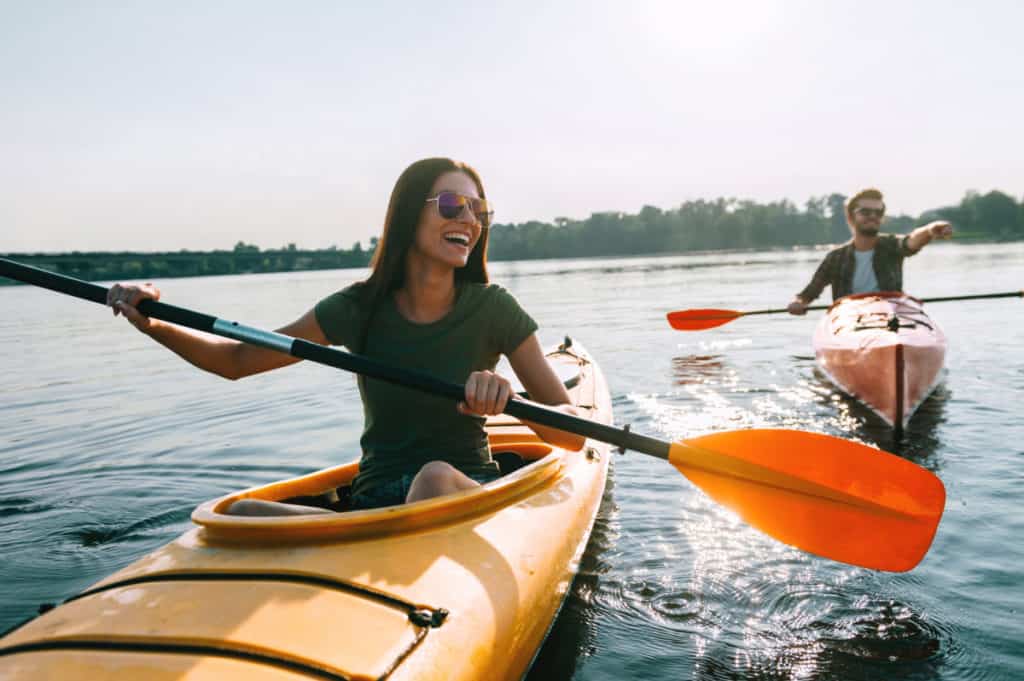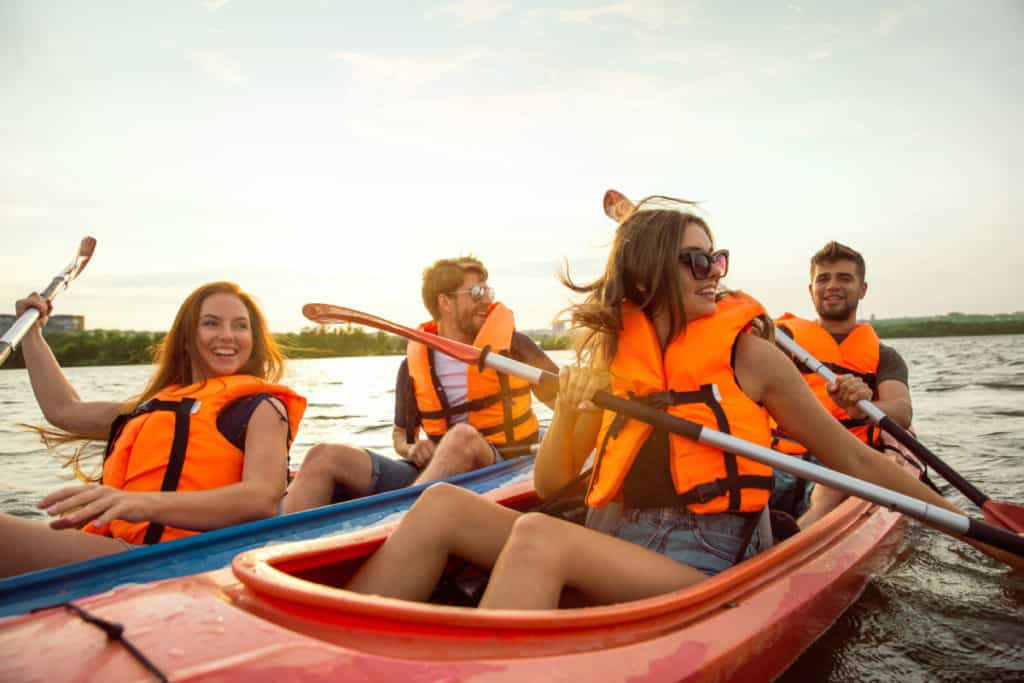
Though it is not difficult to move a kayak forward when learning to paddle, but to be able to paddle that kayak effectively and efficiently you may want to learn its techniques properly. So, if you are new to kayaking then you might want to consider getting kayaking lessons from a reputed online or offline advisor. Some basic information about these lessons is provided in this write-up for your consideration.
Arranging the things required for kayaking
When you are joining a kayaking class you do not need to buy a boat instantly, some classes will have kayaks for you to use if not you can borrow one from a friend or rent one from a store that deals in boat rentals. In this way, you can start taking kayaking lessons at a very low cost. However, you may need to arrange a few other pieces of gear and clothing specifically required for kayaking.
You can also arrange fundamental gear and boat by signing up a kayaking tour as the package of such tours includes everything required for this purpose.
You can also get everything required to learn kayaking by signing up for a kayaking class as they also provide everything like the operators of the kayaking tour.
Clothing and gear required for kayaking
While kayaking the kayaker has to wear the right clothing and safety gear. In this write-up, you will know about the clothing and gear required by the kayakers using a classic kayak.
A classic kayak has a cockpit and one or two hatches that are used for stowing gear. A stable but wide boat without a cockpit can also be used by your instructor for teaching you kayaking if the water and weather are warm.
Gear essentially required for kayaking lessons
- PFD : Should be coastguard approved and fit you properly
- Paddle : Should fit comfortably in your hands
- Spray skirt : To keep you dry and keep water out of the kayak
- Bilge pump : Just in case to much water gets in the kayak
Clothing required for kayaking
- Non-cotton shorts or swimwear
- Non-cotton rash-guard top with long or short sleeves
- Hat with sun-shield
- Neoprene footwear
- Rain or spray pants and jacket according to weather
- Lightweight fleece vest or jacket according to weather
- A wetsuit for kayaking in water colder than 60 degrees F
Items for personal use
- Snacks and lunch depending upon the length of your tour
- Lots of water
- First-aid kit
- Sunglasses, sunscreen, and lip balm
- Watch Signaling whistle
- Dry bags
- Headlamp
Start kayaking
After gathering your clothing and gear along with a kayaking boat you will learn how to adjust your kayak in kayaking lessons.
- It will be comfortable for you to paddle a well-adjusted and stable kayak. The boat should be adjusted by focusing on three contact points when it is still on dry land.
- Firmly hold your butt against the back of the seat. You can also adjust the angle of the seat back or the seat to improve the level of your comfort, power, and balance.
- Use foot pegs to put the balls of your feet: you should adjust foot pegs by sliding and tilting them to keep your knees in a slightly bent position.
- Ensure that your bent knees are firmly in contact with the sides of the cockpit. While paddling, it will allow you to control the side-way motions of the boat. Your fit with the backseat should be snug but not jammed. It will allow you to get out of the boat when overturned.
Tips to Launch Your Kayak

Kayaking trips mostly start with launching the kayak gradually from a sloped shore instead of a sandy, cemented or rocky surface.
You can ask a friend to help you in putting your kayak in the water if you’re not at the point of being able to do it yourself. You should set your boat perpendicular to the shoreline in the shallow water. The stern should be close to the shore and the bow should face away from the shore while launching it perpendicular to the shoreline.
- You should put one of the paddle blades in front of the cockpit under the deck line with shaft stuck out like an outrigger on the sideways
- Stand on the kayak with one leg on each side of the cockpit
- Now set your butt on the seat of the cockpit and grab the cockpit. Now slide your feet into the cockpit by lifting your legs.
- Set both your feet easily on the foot pegs and butt back in the seat firmly
- Now move your kayak past the boat wakes and incoming waves after grabbing the paddle. If you have a spray skirt, you can attach it now.
- You should paddle into the position of launching a kayak when you want to get out of the boat later on and reverse all the steps of launching the boat.
Tips to hold the paddle of your kayak
To hold the paddle of your kayak you should hold the paddle from its center with both of your hands keeping its blades at the top. Now bend your elbows at a 90-degree angle to be in the right position to start kayaking. You will hold it in the right position by lowering the paddle and following the tips provided hereunder.
- The blades of the paddle should be in one line. Your paddle can be feathered if they are not in line with each other. You should adjust the blades in one line if they are not by twisting or pushing the setting button found in the center of the shaft. Though feathered blades are best for cutting through the wind but for first-timers, it can be very tricky to use them.
- You should ensure that the longer edge of both the blades is on the top by observing both of them. You can move your blades efficiently and smoothly through the water if they are in the right position. However, either side of the blades can be up if they are shaped uniformly.
- You should also ensure that the side of the blades with a subtle scoop should be towards you.
- You should keep the paddle shaft in line with the top of its blades by placing your large knuckles on the top of the shaft.
- Now grip the shaft with your index finger and thumb and gently laying other fingers on the shaft. It is unnecessary to try out your hands quickly and gripping the paddle at this stage.
Thus you are ready for kayaking after taking kayaking lessons about different types of strokes.
Pros and cons of kayaking
Pros
Kayaking offer you a number of advantages like:
- Weight loss
- Reduce stress
- Mental happiness
- Increase social connectivity
- Workout for your upper body
- Healthy heart
- Tone of your legs
- Strong core muscles
- Intake of vitamin D
Cons
Everything that has advantages also has certain disadvantages and kayaking is not an exception to this rule. Some of the disadvantages of going kayaking may include:
- Incorrect use of PFD
- Overexposure to the sun
- Dehydration
- Severe weather
- Hypothermia
- Undercut rocks
- Other boats and ships
Pros
Weight loss: The physical activities performed while taking kayaking lessons can help you lose weight effectively.
Reduce stress: You can reduce your stress due to any reason by using your muscle power to cut through the water in the natural environment.
Mental happiness: Kayaking is one of the aerobic exercises which help in improving the health of your mind. Your brain releases certain chemicals to boost your confidence and mood during aerobic exercises.
Increase social connectivity: During kayaking lessons, you can make new friends which will increase your social circle.
Workout for your upper body: Kayaking is the best workout for your upper body. The use of shoulders, arms, and back while paddling can improve your upper body muscles
Healthy heart: The physical exercise during kayaking can maintain the health of your heart.
Tone of your legs: Along with the upper body, kayaking lessons are also beneficial for your legs as you have to balance your kayak with your legs.
Strong core muscles: Kayaking can also make your core muscles like abs stronger than ever.
Intake of vitamin D: While kayaking you are exposed to sunlight which increases the intake of vitamin D.
Cons
Incorrect use of PFD: People use the worn PFDs or do not wear them all the time.
Overexposure to the sun: While taking kayaking lessons you are exposed to the sun for a long time
Dehydration: Overexposure to sun rays can cause dehydration.
Severe weather conditions like lightning etc.: Weather can change fast and at anytime when you are kayaking.
Cold shock and hypothermia: The risk of getting cold shock or hypothermia can increase if your kayak turns over in cold waters.
Undercut rocks: The undercut rocks in the water can damage your kayak.
Other boats and ships: If you are kayaking in the ocean or lake then you may be overlooked by the ships and large boats and can meet an accident if you cannot control your kayak effectively.
Who benefits from kayaking lessons
Kayaking lessons can be beneficial not only for the beginners but also for the experienced kayakers. On the one hand, the beginners can learn how to start kayaking and on the other hand experienced but casual kayakers can hone their skills by joining these lessons from time to time. It’s also good for experienced kayakers to take a kayaking class every so often to help break any bad habits they may have gotten in to. So, everyone can benefit from taking kayak lessons.
So if you love to be part of an adventurous water sport then you should consider joining a kayaking class as soon as possible.